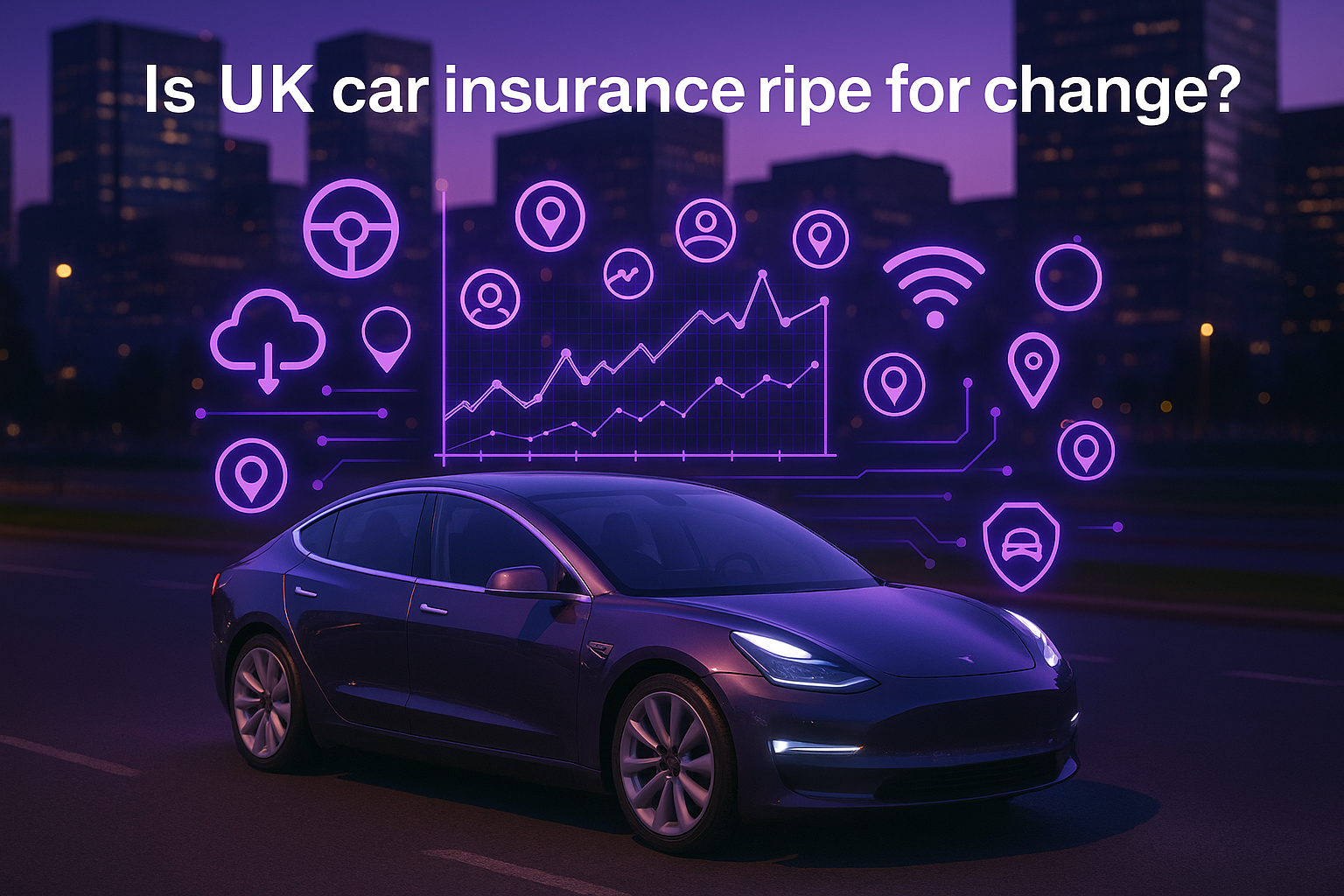Recently, the story of Tesla’s insurance offering in the US caught our attention: not only does Tesla build and sell cars, but it also insures them. This raises the question: could the UK motor insurance market follow suit, and how would traditional insurers respond?
What Tesla is doing
Tesla launched its own insurance business in California in August 2019, promising rates up to 20-30% lower than traditional carriers, using real driving data from the vehicle itself (rather than relying purely on proxies such as age, postcode or credit score).
The key feature: the vehicle’s built-in telematics systems track driving behaviour (mileage, braking, turning, cornering, etc) and Tesla calculates a “Safety Score” based on actual driving patterns. Premiums then adjust based on performance.
Because the OEM (Tesla) owns the vehicle hardware, the telematics infrastructure, and the data, it has an underwriting advantage: it knows risk more precisely than a standalone insurer might.
More broadly, many other OEMs (GM, Ford, Honda, Toyota, Mercedes-Benz, Stellantis, Volkswagen, Kia, Hyundai) are moving into dynamically-priced insurance using embedded telematics
Analysts see this as a ‘strategic land grab’ for the future of mobility (insurance + vehicle + data) rather than a sideline business.
The UK motor-insurance market: ripe for change?
The UK motor-insurance market is under pressure: rising repair costs, increased claims, squeezed margins, and regulatory scrutiny.
Telematics-based insurance (sometimes known as Usage-Based Insurance or Pay-How-You-Drive) is already growing in the UK and Europe.
According to one forecast, the UK vehicle telematics market (which is not insurance alone but related) is projected to grow strongly from 2025 to 2031.
Industry commentary warns that as connected vehicles become ubiquitous, OEMs might indeed bundle insurance and thus reshape risk-pricing and the value chain.
So could an OEM in the UK offer embedded insurance like Tesla?
There is certainly a pathway: connected vehicles are becoming standard, telematics infrastructure is increasingly built into cars, and consumers are more aware of behaviour-based pricing.
However, regulatory, cultural and data-privacy issues matter. For example, using vehicle telematics data for underwriting raises questions about consent, transparency, and fairness.
OEMs in the UK would need to build or partner for insurance underwriting, claims management, and regulatory licensing. Tesla has done this in certain jurisdictions via partnerships.
How would this disrupt the traditional insurer model?
Traditional insurers often rely on ‘proxies’: age, postcode, credit history, previous claims, etc. OEM-embedded insurance shifts the risk pricing toward actual behaviour and vehicle data.
This gives the OEM (or embedded insurer) a data advantage: they own the vehicle telemetry, know real usage, know how features/ADAS (advanced driver-assistance systems) perform, and may thereby reduce claims or detect risk earlier.
Traditional insurers might face margin pressure and could be squeezed from two sides: OEMs offering lower premiums based on better data, and new entrants/insurtechs doing the same.
However, consumer trust and willingness to share vehicle data: while many drivers accept black-box policies (especially young drivers), there is still reluctance and lingering perceptions.
Regulatory complexity: insurance is heavily regulated in the UK; any new entrant or business model must navigate licensing, data-protection, and fairness requirements.
Legacy risks: many vehicles on UK roads are not the latest connected vehicles; embedding the model will take time until the fleet is sufficiently data-rich.
Insurers still face high overheads and claims risks: even with better data, the cost of vehicle repairs, labour, and parts (especially for EVs) remains high, limiting how much premium reduction is possible in the short term.
What are the signs that it might happen anyway?
Telematics growth: UK surveys show telematics/UBI is already gaining ground.
OEMs entering insurance/embedded models: commentary notes that manufacturers are looking to bundle insurance with their mobility offerings.
Technology advances: connected vehicles, IoT, cloud analytics, and AI underwriting; all these make the embedded model more feasible.
What this means for stakeholders
* Drivers: Potentially more tailored premiums (pay based on actual driving behaviour), and possibly lower premiums for safe drivers, especially in connected, newer vehicles. But also more data sharing and possibly less “privacy”.
* OEMs: A new revenue stream (insurance) and stronger control over the customer relationship (vehicle + finance + insurance + data).
* Insurers: Need to adapt either by partnering with OEMs, developing their own telematics/behaviour-based models, or risk disintermediation. Traditional underwriting models may become less competitive.
* Regulators / policy-makers: Need to ensure fairness, transparency, data protection, and that the use of vehicle/behaviour data does not lead to unfair discrimination.
So the UK insurance market could follow Tesla and others in the US and elsewhere. The ingredients are there: connected vehicles, data, demand for safer driving, and pressure on traditional insurance margins, but it won’t happen overnight.
For a company like Laird (with a focus on innovation, accuracy, speed and technology use), this trend offers an opportunity to partner with insurers or OEMs, or to build new services around telematics data.
From our perspective, the key will be to stay pragmatic about what drives value: real data, real insight, and real customer benefit, not just flashy telematics sensors. The future will reward those who combine strong domain expertise (vehicle assessment, claims investigation) with strong data/tech capabilities.

